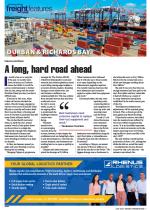It would come as no surprise if the past 12 months went down in history as Durban’s annus horribilis. It would be a gross understatement to declarethat the city, along with the entire KwaZulu-Natal province, has had a difficult year.It started in July 2021, when violent civil unrest shocked the nation. Chaotic images emerged as various towns across KwaZulu-Natal fell prey to anarchy and brazen theft. But it was the frenzy of looting and arson in Durban in particular that left many South Africans fearful. The city had hardly recovered when, in April this year, several months’ worth of rain pelted down on the province in a single day. Thousands of people were displaced, while hundreds of homes and businesses were destroyed in the worst f looding in Durban in at least six decades.In May, the heavens opened yet again and more f looding occurred, leaving the city reeling.Tshegang Chipeya is programme manager for The Durban EDGE, eThekwini Municipality’s economic research and advisory platform aimed at providing cutting-edge insights to economic decision-makers. Speaking during a recent online event, she said business confidence was understandably low. This was evident from extensive surveys that had been conducted across the city in recent weeks, as part of an ongoing effort to understand the challenges business owners were facing.“Business morale is low. An encouraging outcome from the surveys, however, is that despite the confidence levels not being high, there is real determination to overcome the current situation, and businesses are working hard to re-open as quickly as possible.”Chipeya said initial estimates priced the damage at R7 billion. “Most businesses have indicated that it will take up to three months to re-open, depending on the infrastructure upgrades required. One notable response has been that most businesses need extensive capital to replace their lost equipment and stock.”Current priorities, she said, were repairing roads, contracting labour and equipment for clean-up work, and restoring water a nd elec tr icit y.“A total of 1 152 formal businesses have sustained serious damage due to the f loods. Most of these businesses were established along the city’s f lood plain, a vulnerable area. Going forward, this risk will have to be assessed.”According to Chipeya, an annual rate income of R513.2 million is at risk for the city due to the f loods. “The biggest damage was to businesses in the industrial sector at R3.7 billion, followed by the commercial sector, which saw damages totalling about R2.2 billion.”She said it was now clear that not enough attention had been paid to the city’s f lood plain and how vulnerable it had left Durban as a result of so many businesses having been established in the south-eastern part of the city.“Retrospective infrastructure adjustments will be required going forward. This, to future-proof the area against any future f looding.”Of particular concern, she added, were the massive losses suffered by the motor vehicle manufacturing sector. “It is an incredibly important sector to the local economy as it’s the largest exporting sector in Durban, responsible for about one-fifth of the c i t y ’s G D P.”She said Durban overall had lost production of about 1.6%, adding that while this did not sound like much – considering the city was forecast to grow by only 1.2% this year – the situation was indeed dire.

